
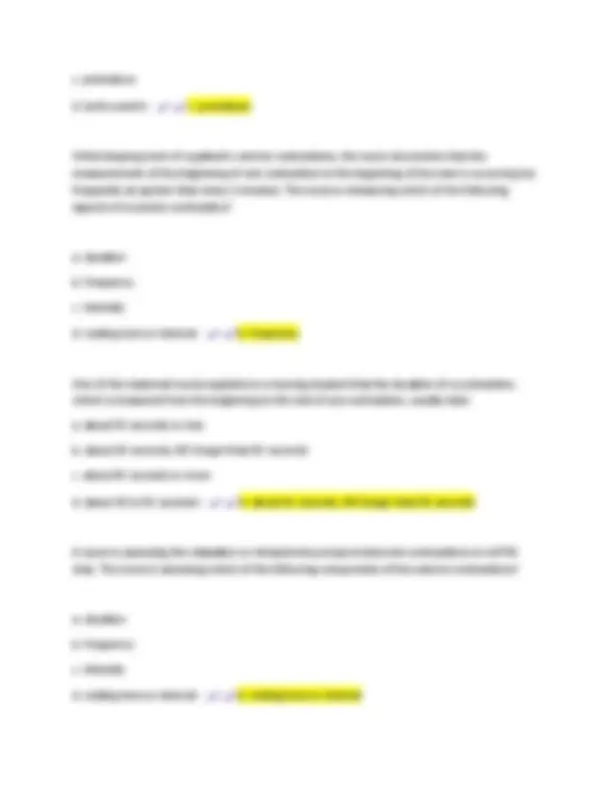
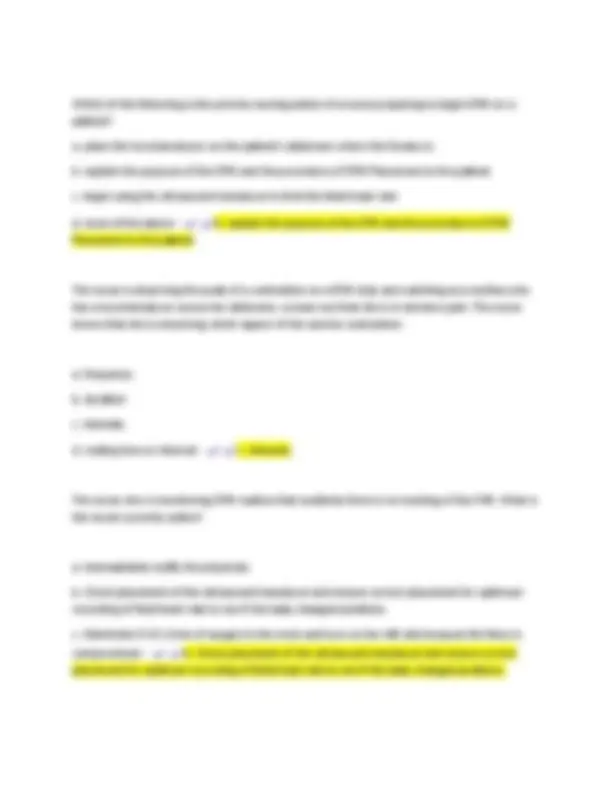
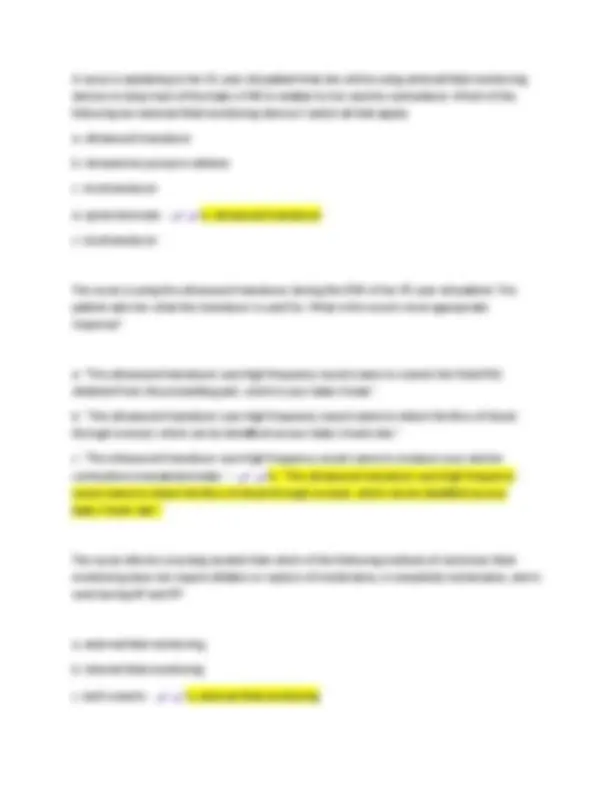
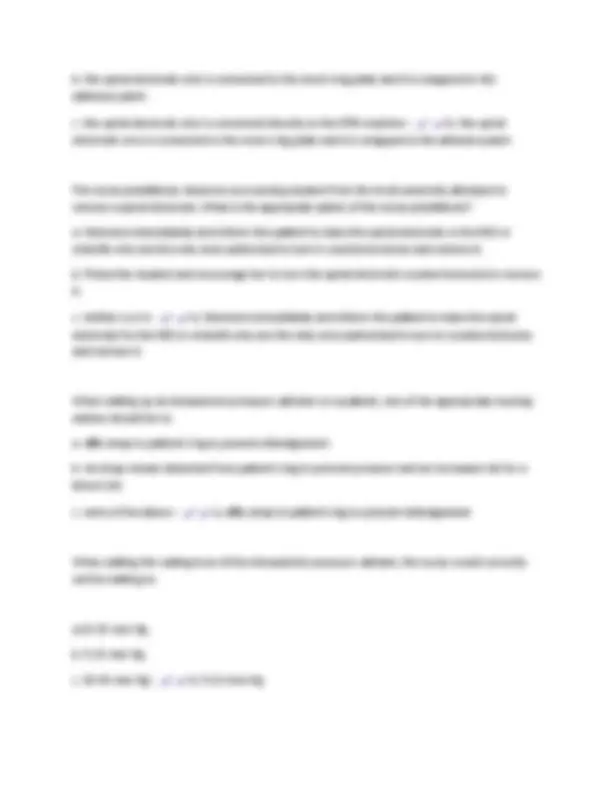
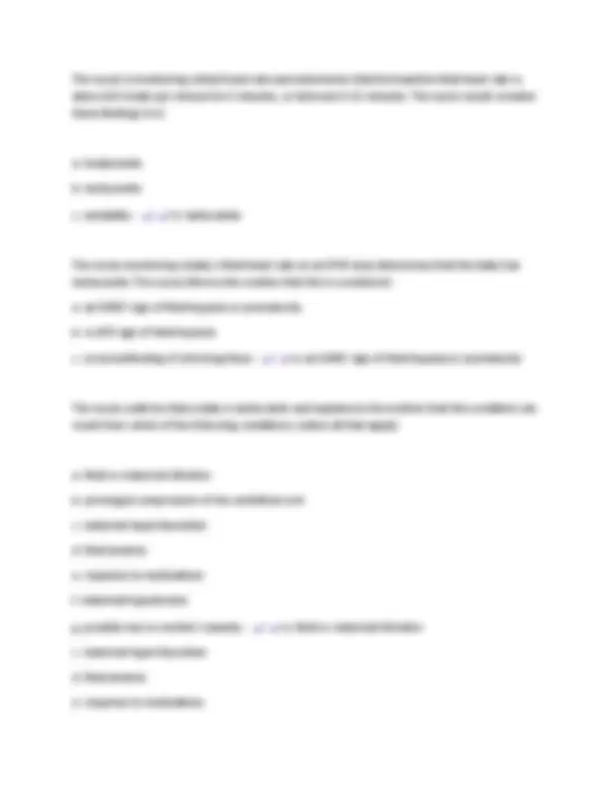
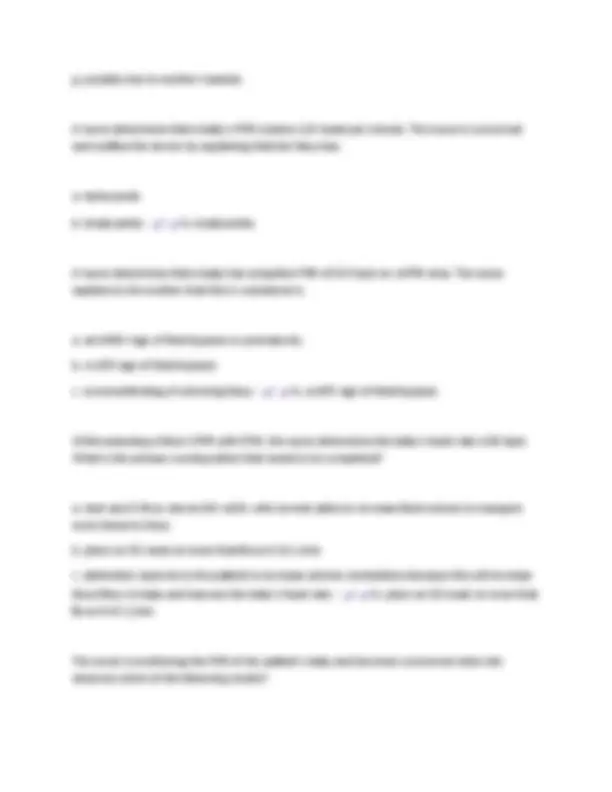
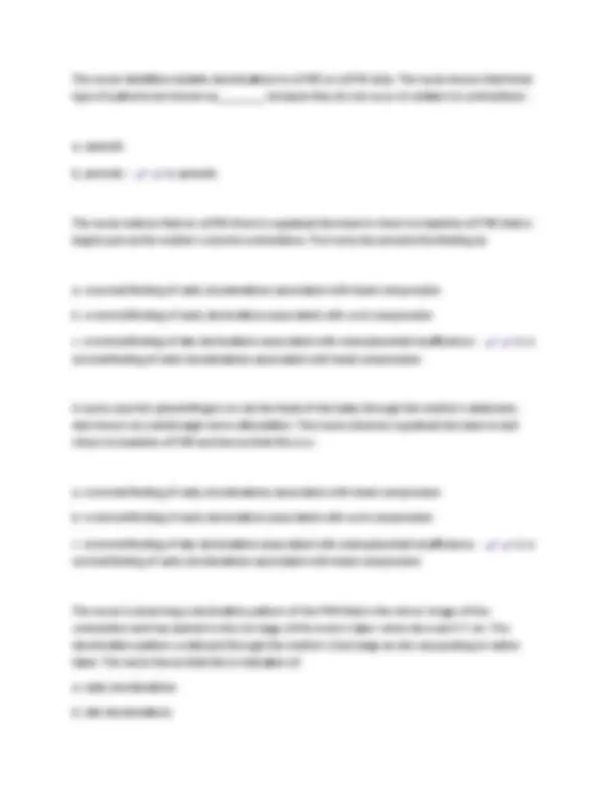
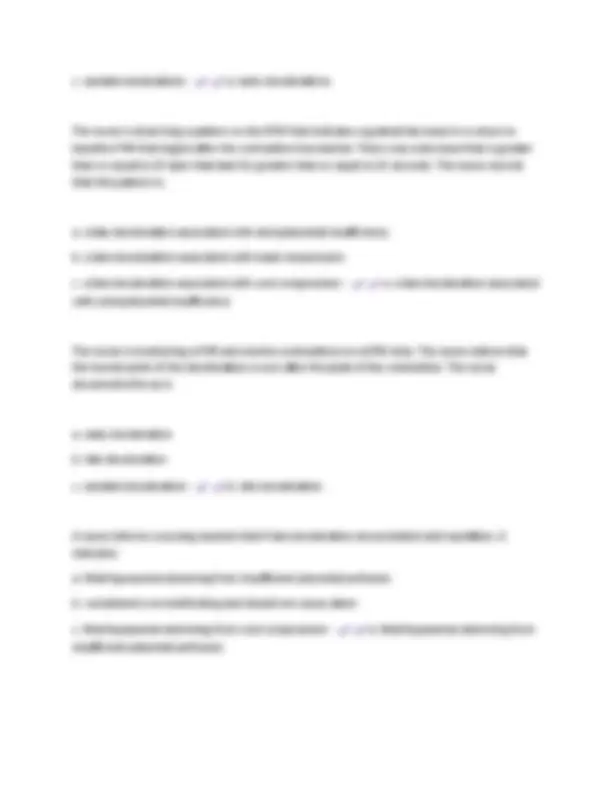
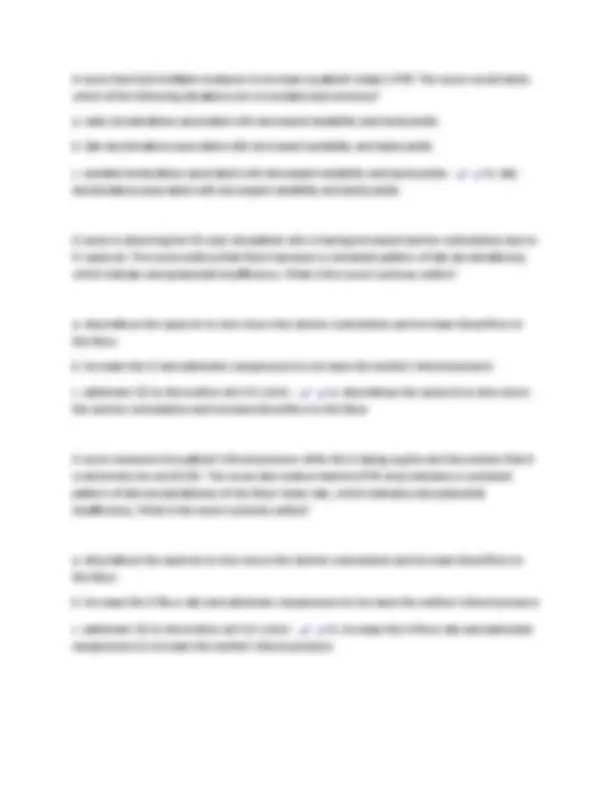


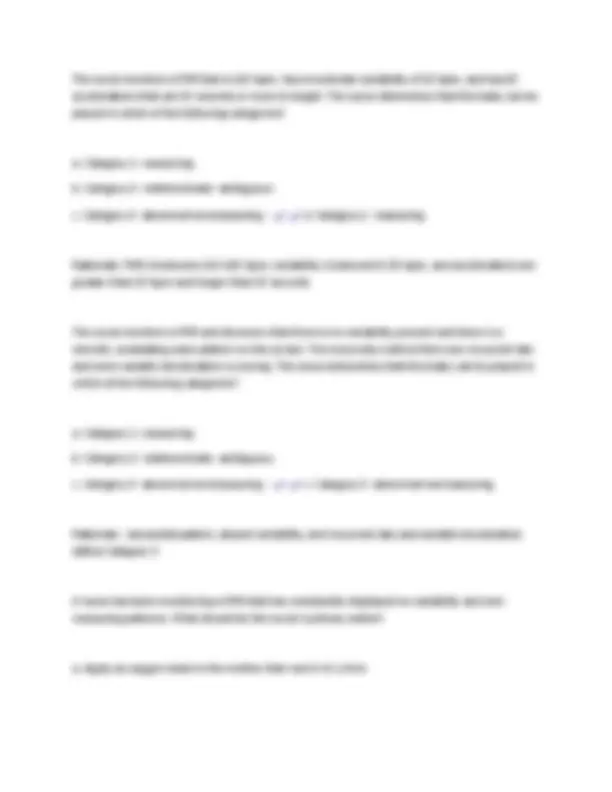
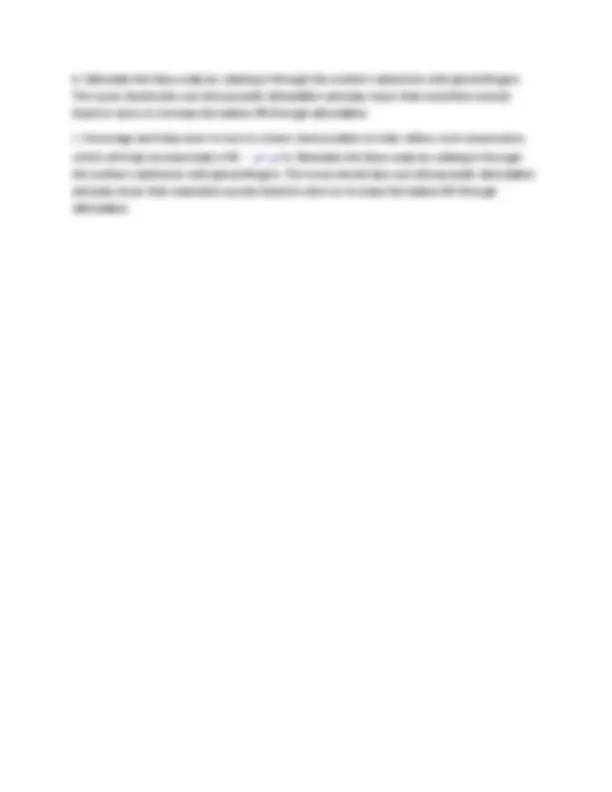


Study with the several resources on Docsity

Earn points by helping other students or get them with a premium plan


Prepare for your exams
Study with the several resources on Docsity

Earn points to download
Earn points by helping other students or get them with a premium plan
Community
Ask the community for help and clear up your study doubts
Discover the best universities in your country according to Docsity users
Free resources
Download our free guides on studying techniques, anxiety management strategies, and thesis advice from Docsity tutors
A nurse is explaining to a pregnant patient the purpose of electronic fetal monitoring. Which of the following statements by the nurse is the most accurate way to describe the purpose of EFM? a. "EFM is a diagnostic procedure that monitors your baby's heart rate or FHR and your uterine contractions. b. "EFM is a screening procedure that monitors your baby's heart rate or FHR and your uterine contractions." c."EFM is a screening procedure that only monitors your baby's heart rate or FHR." d. "EFM is a diagnostic procedure that only monitors the frequency, duration, and intensity of your uterine contractions." - b. "EFM is a screening procedure that monitors your baby's heart rate or FHR and your uterine contractions." The nurse measures fetal well being during labor by paying attention to: a. the response of the FHR to uterine contractions b. mom's complaint of pain during the labor c. the FHR only d. the frequency, duration, and intensity of the mother's
Typology: Exams
1 / 21

This page cannot be seen from the preview
Don't miss anything!














A nurse is explaining to a pregnant patient the purpose of electronic fetal monitoring. Which of the following statements by the nurse is the most accurate way to describe the purpose of EFM? a. "EFM is a diagnostic procedure that monitors your baby's heart rate or FHR and your uterine contractions. b. "EFM is a screening procedure that monitors your baby's heart rate or FHR and your uterine contractions." c."EFM is a screening procedure that only monitors your baby's heart rate or FHR." d. "EFM is a diagnostic procedure that only monitors the frequency, duration, and intensity of your uterine contractions." - b. "EFM is a screening procedure that monitors your baby's heart rate or FHR and your uterine contractions." The nurse measures fetal well being during labor by paying attention to: a. the response of the FHR to uterine contractions b. mom's complaint of pain during the labor c. the FHR only d. the frequency, duration, and intensity of the mother's uterine contractions only - a. the response of the FHR to uterine contractions A nursing student explains during her presentation that the 5 factors for adequate fetal oxygenation include:
Which of the following is the priority nursing action of a nurse preparing to begin EFM on a patient? a. place the tocotransducer on the patient's abdomen where the fundus is b. explain the purpose of the EFM and the procedure of EFM Placement to the patient c. begin using the ultrasound transducer to find the fetal heart rate d. none of the above - b. explain the purpose of the EFM and the procedure of EFM Placement to the patient The nurse is observing the peak of a contraction on a EFM strip and watching as a mother,who has a tocotransducer across her abdomen, scream out that she is in extreme pain. The nurse knows that she is observing which aspect of the uterine contraction: a. frequency b. duration c. intensity d. resting tone or interval - c. intensity The nurse who is monitoring EFM realizes that suddenly there is no tracking of the FHR. What is the nurse's priority action? a. Immeadietely notify the physician. b. Check placement of the ultrasound transducer and ensure correct placement for optimum recording of fetal heart rate to see if the baby changed positions. c. Administer 8-10 L/min of oxygen to the mom and turn on her left side because the fetus is compromised. - b. Check placement of the ultrasound transducer and ensure correct placement for optimum recording of fetal heart rate to see if the baby changed positions.
A nurse is explaining to her 31 year old patient that she will be using external fetal monitoring devices to keep track of the baby's FHR in relation to her uterine contractions. Which of the following are external fetal monitoring devices? (select all that apply) a. ultrasound transducer b. intrauterine pressure catheter c. tocotransducer d. spiral electrode - a. ultrasound transducer c. tocotransducer The nurse is using the ultrasound transducer during the EFM of her 35 year old patient. The patient asks her what the transducer is used for. What is the nurse's most appropriate response? a. "The ultrasound transducer uses high frequency sound waves to convert the Fetal EKG obtained from the presenting part, which is your baby's head." b. "The ultrasound transducer uses high frequency sound waves to detect the flow of blood through a vessel, which can be identified as your baby's heart rate." c. "The ultrasound transducer uses high frequency sound waves to measure your uterine contractions transabdominally." - b. "The ultrasound transducer uses high frequency sound waves to detect the flow of blood through a vessel, which can be identified as your baby's heart rate." The nurse informs a nursing student that which of the following methods of electronic fetal monitoring does not require dilation or rupture of membranes, is completely noninvasive, and is used during AP and IP? a. external fetal monitoring b. internal fetal monitoring c. both a and b - a. external fetal monitoring
Which of the following EFM devices can be used for a patient whose membranes ruptured and has a cervix that is already 50% dilated to detect FHR? a. tocotransducer b. ultrasound transducer c. spiral electrode d. intrauterine pressure catheter - c. spiral electrode The nurse explains to a patient that the intrauterine pressure catheter is being used to: a. monitor her baby's FHR and her uterine contractions at the same time b. monitor her baby's FHR and converting into an EKG wave c. Monitor the frequency, duration, and pressure of her uterine contractions by measuring intrauterine pressures and converting it to mm HG - c. Monitor the frequency, duration, and pressure of her uterine contractions by measuring intrauterine pressures and converting it to mm HG The doctor asks the nurse to pass him which specific device to infuse fluids into a mother who has olgiohydraminos or low amniotic fluid during an aminocentesis procedure? a. intrauterine pressure catheter b. tocotransducer c. ultrasound transducer d. spiral electrode - a. intrauterine pressure catheter After applying the spiral electrode onto the baby's head, the nurse needs to ensure that: a. the spiral electrode wire is connected to the mom's plate on her chest and it is snapped to the adhesive patch
b. the spiral electrode wire is connected to the mom's leg plate and it is snapped to the adhesive patch c. the spiral electrode wire is connected directly to the EFM machine - b. the spiral electrode wire is connected to the mom's leg plate and it is snapped to the adhesive patch The nurse practitioner observes as a nursing student from the local university attempts to remove a spiral electrode. What is the appropiate action of the nurse practitioner? a. Intervene immediately and inform the patient to leave the spiral electrode or the MD or midwife who are the only ones authorized to turn it counterclockwise and remove it. b. Praise the student and encourage her to turn the spiral electrode counterclockwise to remove it. c. neither a or b - a. Intervene immediately and inform the patient to leave the spiral electrode fro the MD or midwife who are the only ones authorized to turn in counterclockwise and remove it. When setting up an intrauterine pressure catheter on a patient, one of the appropriate nursing actions should be to: a. affix strap to patient's leg to prevent dislodgement b. let strap remain detached from patient's leg to prevent pressure and an increased risk for a blood clot c. none of the above - a. affix strap to patient's leg to prevent dislodgement When setting the resting tone of the intrauterine pressure catheter, the nurse would correctly set the setting to: a.10-20 mm Hg b. 5-10 mm Hg c. 30-40 mm Hg - b. 5-10 mm Hg
g. possibly due to mother's anxiety A nurse determines that a baby's FHR is below 110 beats per minute. The nurse is concerned and notifies the doctor by explaining that the fetus has: a. tachycardia b. bradycardia - b. bradycardia A nurse determines that a baby has a baseline FHR of 100 bpm on a EFM strip. The nurse explains to the mother that this is considered a: a. an EARLY sign of fetal hypoxia or prematurity b. a LATE sign of fetal hypoxia c. a normal finding of a thriving fetus - b. a LATE sign of fetal hypoxia While assessing a fetus's FHR with EFM, the nurse determines the baby's heart rate is 98 bpm. What is the primary nursing action that needs to be completed? a. start and IV flow rate at 200 ml/hr with normal saline to increase fluid volume to transport more blood to fetus b. place on O2 mask on mom that flows 8-10 L/min c. administer oxytocin to the patient to increase uterine contractions because this will increase blood flow to baby and improve the baby's heart rate - b. place an O2 mask on mom that flows 8-10 L/min The nurse is monitoring the FHR of her patient's baby and becomes concerned when she observes which of the following results?
a. presence of variability of 6-25 bpm b. absence of variability, which is considered nonreassuring c. a temporary decrease in variability while the fetus is in the sleep state - b. absence of variability, which is considered nonreassuring The nurse is monitoring the FHR of the patient's baby. The nurse sees a temporary decrease in variability but then the variability rises back to 20 bpm. The nurse does which of the following actions: a. Notify doctor because fetus could be compromised. b. Record these as normal findings because a temp. decrease in variability is associated with the fetus being in a sleeping state. c. Turn mom onto her left side because the fetus may be lacking oxygen in utero. - b. Record these as normal findings because a temp. decrease in variability is associated with the fetus being in a sleeping state. Which of the following conditions lead to decreased variability found in the FHR? (select all that apply) a. fetal hypoxemia b. acidosis c. prolonged cord compression d. maternal hypotension e. medications that depress the CNS, such as narcotics and analgesics - a. fetal hypoxemia b. acidosis e. medications that depress the CNS, such as narcotics and analgesics
The nurse identifies variable decelerations in a FHR on a EFM strip. The nurse knows that these type of patterns are known as________ because they do not occur in relation to contractions : a. episodic b. periodic - a. episodic The nurse notices that on a EFM there is a gradual decrease in return to baseline of FHR that is begins just as the mother's uterine contractions. The nurse documents this finding as: a. a normal finding of early decelerations associated with head compression b. a normal finding of early declerations associated with cord compression c. a normal finding of late declerations associated with uteroplacental insufficiency - a. a normal finding of early decelerations associated with head compression A nurse uses her gloved fingers to rub the head of the baby through the mother's abdomen, also known as cranial vagal nerve stimulation. The nurse observes a gradual decrease in and return to baseline of FHR and knows that this is a : a. a normal finding of early decelerations associated with head compression b. a normal finding of early declerations associated with cord compression c. a normal finding of late declerations associated with uteroplacental insufficiency - a. a normal finding of early decelerations associated with head compression The nurse is observing a decleration pattern of the FHR that is the mirror image of the contraction and has started in the 1st stage of the mom's labor when she was 4-7 cm. The deceleration pattern continued through the mother's 2nd stage as she was pushing in active labor. The nurse knows that this is indicative of: a. early decelerations b. late decelerations
c. variable declerations - a. early decelerations The nurse is observing a pattern on the EFM that indicates a gradual decrease in a return to baseline FHR that begins after the contraction has started. There was a decrease that is greater than or equal to 15 bpm that lasts for greater than or equal to 15 seconds. The nurse records that this pattern is: a. a late deceleration associated with uteroplacental insufficiency b. a late deceleration associated with head compression c. a late deceleration associated with cord compression - a. a late deceleration associated with uteroplacental insufficiency The nurse is monitoring a FHR and uterine contractions on a EFM strip. The nurse notices that the lowest point of the deceleration occurs after the peak of the contraction. The nurse documents this as a: a. early deceleration b. late deceleration c. variable deceleration - b. late deceleration A nurse informs a nursing student that if late deceleration are persistent and repetitive, it indicates: a. fetal hypoxemia stemming from insufficient placental perfusion b. considered a normal finding and should not cause alarm c. fetal hypoxemia stemming from cord compression - a. fetal hypoxemia stemming from insufficient placental perfusion
While monitoring a mother and baby during EFM, the nurse notices that there are consistent patterns of drops of the FHR from the baseline after the contraction has ended. The patient is lying supine with her feet elevated. What is the primary nursing action at this time? a. change maternal position to lateral to increase oxygenation to fetus b. increase IV flow rate to 200 ml/hr to increase mom's blood pressure c. notify the doctor and then increase the IV flow rate to 200 ml/hr to increase mom's blood pressure - a. change maternal position to lateral to increase oxygenation to fetus Nurse Janet notices an abrupt decrease in FHR below the baseline that is greater than or equal to 15 bpm and lasts greater than or equal to 15 seconds. The nurse notes that these patterns are not occurring in relation to contractions. What would the nurse document this finding as? a. variable decelerations in relation to uteroplacental insufficiency b. variable decelerations in relation to cord compression c. variable decelerations in relation to increased oxygenation to fetus via placenta - b. variable decelerations in relation to cord compression A nurse is monitoring a patient and her baby using EFM. The nurse notices and becomes concern when she sees a consistent pattern of variable deceleration(s). She notices that the mother is laying on her right side. What is the primary nursing action that needs to be performed? a. discontine oxytocin IV b. encourage mom to move from side to side and go in a knee-chest position to relieve umbilical cord compression c. begin adminstering oxygen through a mask at levels 10-20 l/min - b. encourage mom to move from side to side and go in a knee-chest position to relieve umbilical cord compression
A doctor has just completed an ultrasound on a patient that is at 35 weeks gestation. He informs the nurse that the patient has very little amniotic fluid, which is causing the umbilical cord to compress the baby's head. He asks the nurse to begin getting his equipment ready so that he can correct the problem. What is the primary nursing action that needs to be completed? a. discontine oxytocin IV b. encourage mom to move from side to side and go in a knee-chest position to relieve umbilical cord compression c. begin adminstering oxygen through a mask at levels 10-20 l/min d. finding an intrauterine pressure catheter, gloves, and the syringe needed to perform aminocentesis to give the patient more fluid to increase her amniotic fluid levels and relieve umbilical cord compresison - d. finding an intrauterine pressure catheter, gloves, and the syringe needed to perform aminocentesis to give the patient more fluid to increase her amniotic fluid levels and relieve umbilical cord compresison A nurse monitoring FHR during an EFM documents that there is a decrease in FHR baseline that is greater than or equal to 15 bpm and lasts more than 2 minutes but less than 10 minutes. The nurse would document this finding as: a. variable decelerations b. prolonged decelerations c. late decelerations - b. prolonged decelerations A nurse is monitoring FHR during an EFM of a pregnant patient that is 26 weeks. The nurse notices that there has been a persistent decrease in FHR below the baseline of greater than or equal to 15 bpm that has lasted for longer than 10 minutes. The nurse would record this in her charting as: a. A normal expected baseline change. b. A new baseline change since the decrease in FHR lasted longer than 10 minutes.
g. rapid fetal descent - a. sudden cord prolaspe c. maternal hypotension as a result of analgesia/anesthesia d. tetanic contractions e. maternal hypoxia f. placental abruption The nurse asks a nursing student what VEAL represents. The nursing student's proper response was: V__________ E___________ A__________ L____________ - Variable Early Acceleration Late The nurse asks a nursing student what CHOP represents. The nursing student's proper response was: C____________ H____________ O___________ P___________ - Cord compression Head compression Oxygenation Placental insufficiency
The nurse monitors a FHR that is 120 bpm, has a moderate variability of 22 bpm, and has 20 accelerations that are 15 seconds or more in length. The nurse determines that this baby can be placed in which of the following categories? a. Category 1- reassuring b. Category 2- indeterminate- ambiguous c. Category 3- abnormal-nonreassuring - a. Category 1- reassuring Rationale: FHR is betwene 110-160 bpm, variability is between 6-25 bpm, and accelerations are greater than 15 bpm and longer than 15 seconds The nurse monitors a FHR and discovers that there is no variability present and there is a smooth, undulating wave pattern on the screen. The nurse also notices there are recurrent late and even variable deceleration occurring. The nurse determines that this baby can be placed in which of the following categories? a. Category 1- reassuring b. Category 2- indeterminate- ambiguous c. Category 3- abnormal-nonreassuring - c. Category 3- abnormal-nonreassuring Rationale : sinusoidal pattern, absent variability, and recurrent late and variable deceleration define Category 3 A nurse has been monitoring a FHR that has consistently displayed no variability and non- reassuring patterns. What should be the nurse's primary action? a. Apply an oxygen mask to the mother that runs 8-10 L/min.